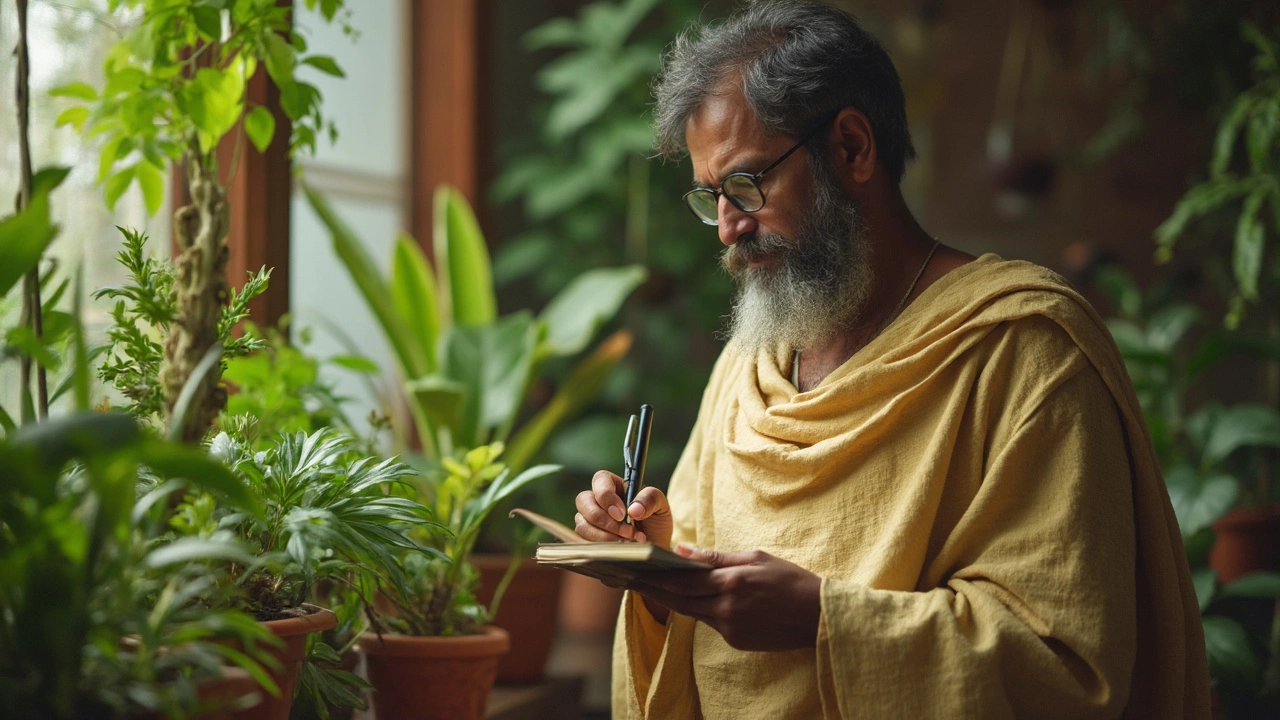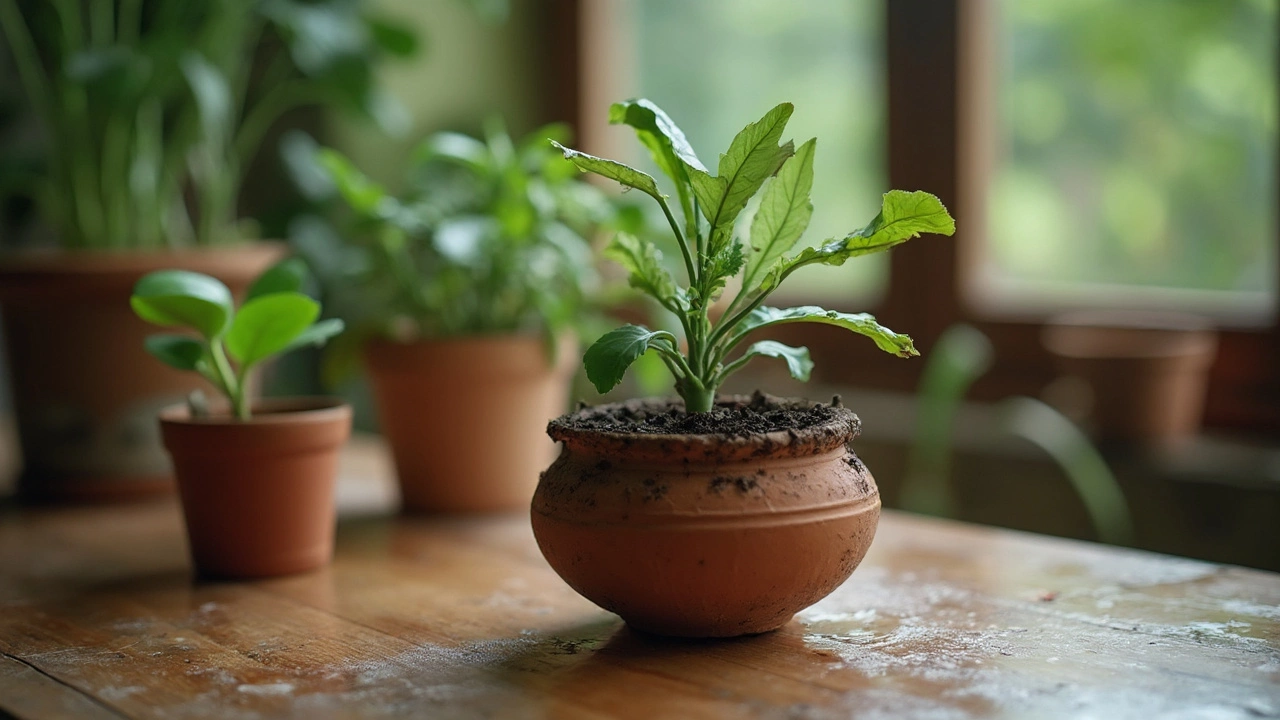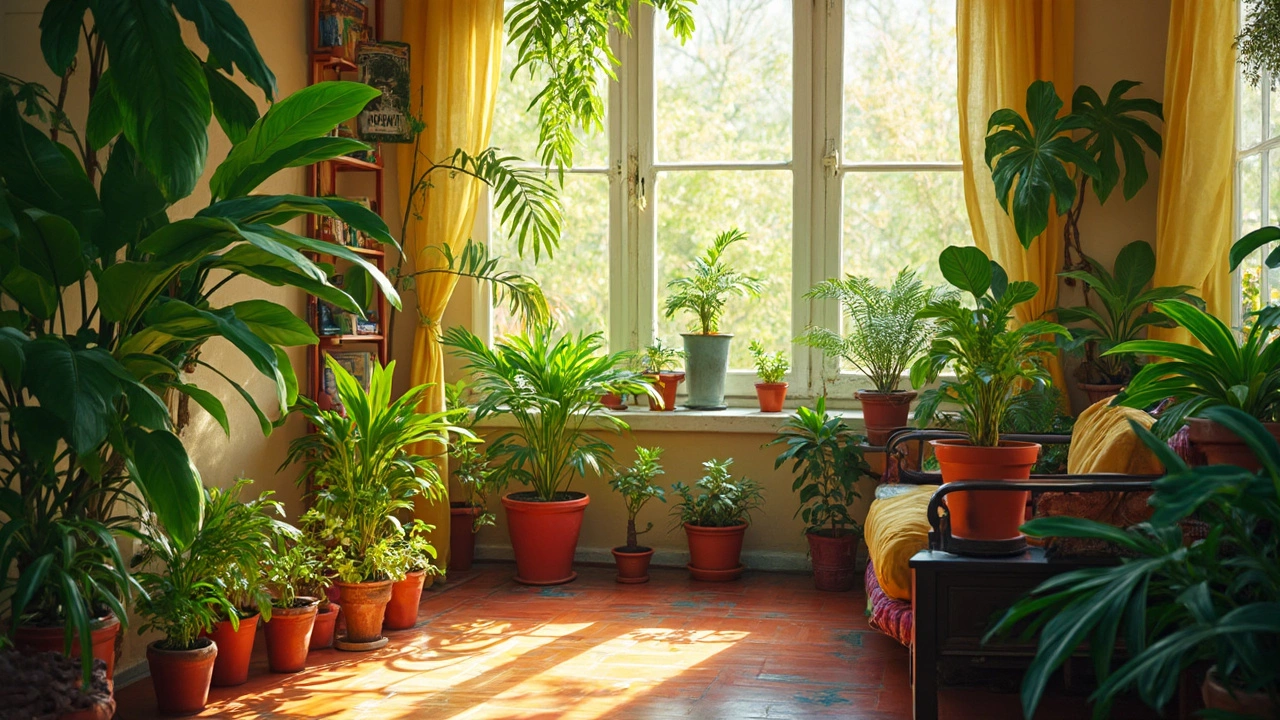We've all been there, thinking we're being plant heroes by keeping our leafy friends hydrated, only to find out we're drowning them instead. Overwatering is like the silent killer of houseplants. It can sneak up on you because it feels counterintuitive; after all, plants need water to live. But figuring out just how much they need can be trickier than you think.
First thing's first, if you're seeing yellowing leaves, that might be a red flag waving, saying, "Help! Too much water!" And those droopy, wilting leaves? They could easily fool you into thinking the plant is thirsty when, in fact, it's had more than its fill. It's like giving someone too much tea when a sip would do.
Another clue to look out for is the soil. Is it soggy or does it smell a bit funky, like something's rotting? That's often a clear sign things are too wet down there. Believe it or not, roots need to breathe just like us, and if they're constantly submerged, they're going to have a hard time doing that.
- Why Overwatering Happens
- The Telltale Signs of Overwatered Plants
- How to Rescue an Overwatered Plant
- Preventing Overwatering Mistakes
- When in Doubt, Let it Dry Out
Why Overwatering Happens
You might think you're doing your plant a favor by watering it frequently, but sometimes, it's actually too much of a good thing. Overwatered plants happen more than you'd think because, let's face it, showing love often means giving extra care. However, it's not always needed.
One classic reason for overwatering is being a bit too enthusiastic about plant care. We've all had that moment where a daily watering routine seems like the best way to watch your green buddy grow. But not every plant is the same. Some prefer drier conditions and can thrive on neglect, while others do need regular watering.
Another culprit could be misunderstanding the signals. Seeing droopy leaves might make you think your plant is thirsty, but as we talked about before, droopiness can also mean it's gotten too much water. It’s all about balance.
And then there's the pot situation. If your pots don't have good drainage, possibly because they lack adequate drainage holes, the water sits in the soil and doesn't escape. This creates a soggy environment, basically a swampy lagoon for your poor indoor plant. The roots get waterlogged, which isn't ideal for their health.
Different seasons and indoor climates can play a role too. In those chilly months, when you turn up the indoor heating, plants might use less water. So, it’s all about understanding these shifts and adjusting your watering routine accordingly.
Indoor plant care sometimes feels like a guessing game, but knowing these common causes means you're already ahead. Next time you reach for the watering can, think about these factors. It might save your greenery from more water than it bargained for.
The Telltale Signs of Overwatered Plants
Alright, let's talk about the clues your plant might be giving you, desperately trying to let you know you've been a bit too enthusiastic with the watering can. Recognizing these signs early can make all the difference in saving your indoor greenery.
The most obvious red flag? Those leaves turning yellow. While it might look like they are just showing their sunny side, it's often a cry for help. Leaves should be vibrant and full of life, not looking sad and washed-out.
Another sneaky signal is soft, mushy stems. If you touch the plant and it feels more like jelly than a sturdy friend, chances are it's been bathing in too much water. If the leaves start dropping for no good reason, that’s another sign that too much moisture is playing a game of sabotaging your plant's health.
Take a close look at the soil. If it's more like a swamp than anything else, that's your cue. The soil should never smell like it's hosting a swamp party. A sour or rotten smell can be an indicator of root rot, which, by the way, is a real bummer for plants.
Sometimes, spotting these signs isn't enough until you've had the roots checked. Healthy roots are firm and white. If they’re brown or black and mushy, it's like finding wet tissues in your plant’s feet - not good!
Here’s a clever trick that's easy to forget: lift your pot. If it feels unusually heavy every time, it might be holding onto too much water. Think of it as the plant equivalent of struggling to move after a big meal - too much of a good thing!

How to Rescue an Overwatered Plant
So, your plant's looking a bit worse for wear thanks to some extra enthusiasm with the watering can. Don't panic! There's hope yet to bring it back from the brink.
First, ease up on the watering! It might sound obvious, but the best way to help is to let things dry out a bit. You can start by temporarily halting waterings until the top inch or so of the soil feels dry.
Next, it's time for a little TLC. Carefully remove the plant from its pot. Check out the roots and look for signs of overwatering damage. Mushy or dark roots need to be snipped away with clean scissors to prevent further rot. Healthy roots are firm and white, so that’s what you want to stick with.
Now, think about the potting situation. Switching to fresh soil can work wonders, especially one that drains well. If your container doesn't have drainage holes, it's time for an upgrade because staying soggy is a big no-no.
- Switch to a Pot with Drainage: Ensuring your plant's pot has proper drainage holes can prevent future overwatering woes.
- Use Fresh, Well-Draining Soil: Look for a soil mix designed for your specific type of plant or aim for a general well-aerated mix.
- Prune Away the Damage: Trim off any yellowing leaves or mushy roots to encourage new growth.
- Replan with Care: Be gentle when repotting to avoid further stress on the plant.
- Wait to Water: Once repotted, don't water immediately. Let it settle in for a few days before offering a light drink.
Finally, find your plant a nice spot with good air movement and indirect light to help it recover. Over time, your green buddy will bounce back with some patience and the right adjustments. Remember, less can sometimes be more, especially when it comes to keeping your indoor plants thriving!
Preventing Overwatering Mistakes
Keeping your indoor flora happy without drowning them can feel like a bit of a balancing act. But with a few simple tricks, you can keep your plants thriving without falling into the overwatered trap.
Start by getting to know your specific plants. Some plants like cacti and succulents need less water, while others like ferns prefer a bit more moisture. Check out your plant's native habitat for hints on its watering needs. It's not one-size-fits-all in the plant world!
Using the right pot and soil is another biggie. Make sure you've got pots with drainage holes. These are crucial for letting excess water escape. Go for well-draining soil mixes, especially if you're dealing with plants that are sensitive to too much water.
Try the finger test if you're unsure when to water. Stick your finger about an inch deep into the soil. If it feels dry, it's probably time to water. If it’s still moist, hold off. This simple trick can prevent those dreaded overwatered plants.
Here's a tip that might surprise you: don't rely too heavily on a set schedule. Instead, be a bit flexible and observe how your plant's needs change with the seasons. Plants tend to dry out slower in winter when the air is more humid, so you might need to water less.
And don't forget about humidity levels and temperature in your home. Providing the right environment can reduce the need for frequent watering. Humidity trays or misting can help, especially in dry or hot rooms.
Lastly, if you want a bit of tech help, a moisture meter can be a game changer. It's a handy little gadget that gives you a clear reading on how wet your plant's soil really is. Just pop it in and let it do the guessing for you.
By making these small adjustments and paying a bit more attention to what your plants are telling you, you'll cut down on overwatering mistakes and keep your green friends thriving.

When in Doubt, Let it Dry Out
Alright, here's the thing: when you're unsure about how much water your plant needs, it's usually safer to err on the side of letting it dry out a bit. Most indoor plants can handle a bit of drought way better than they can cope with a flood. This might sound simple, but it can make a big difference.
Think of your plant's soil like your comfy, dry socks. If they're drenched and soggy all the time, you're bound to be uncomfortable. The same goes for plants. Roots need air pockets in the soil to breathe, and oversaturating the soil fills those pockets with water instead.
So, what's the plan, you ask? Start with your finger. Stick it about an inch deep into the soil. If it feels dry, it probably needs some water. If it's still a bit damp, hold off on watering for a day or two. Easy, right?
Another handy tool is a moisture meter. It's like a tiny little detective for your plants, giving you a reading on how much moisture is in the soil. They're pretty cheap and can take some guesswork out of watering.
For those struggling with overly enthusiastic watering schedules, consider these tips:
- Water in the morning. This allows the sun to help dry out the soil throughout the day.
- Make sure your pot has drainage holes to avoid any water pooling at the bottom.
- Use a well-draining soil mix, especially for succulents and cacti.
- Avoid a strict watering schedule. Let the plant tell you what it needs.
Remember, each plant is a little different. Some thrive with more water, like ferns, while others, like succulents, are happier when they're on the dry side. It's a bit of a balancing act, but with these tips, you'll be well on your way to keeping your plants healthy and happy.

